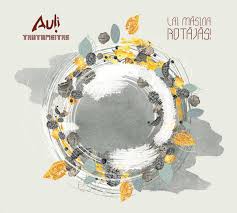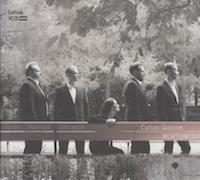Drum and bagpipe ensemble Auļi have long been a major force in Latvian folk music, with their driving beats complemented by the powerful sounds and tones of the bagpipes. A newer group on the Latvian folk music scene is Tautumeitas, who, as their name might indicate, is a collection of young Latvian women singing in a traditional style. In 2017, these two combined their talents and recorded an album entitled Lai māsiņa rotājās!, an album with songs about engagements and weddings.
As Auļi has ten members, and Tautumeitas has six singers (and one bassist), the united ensemble has seventeen musicians and displays a true strength in numbers, with the drums, bagpipes and multiple vocalists coming together to create a broad sonic tapestry, which is at once both traditional and modern. One of the most effective examples of this is the song ‘Dzied’ papriekšu, brāļa māsa’, where the traditional Latvian singing style is meshed with the thundering drums to make for a powerful performance.
Latvian folklore is full of references to the inability of a bride and her groom’s mother to get along, such as in the song ‘Benķa kāja’, where the bride sings “ja tu man’ par beņķa kāja – es tev – veca raganiņ’” (If you say that I am a bench leg, then I will call you an old witch.”) With their confident, expressive singing, Tautumeitas make it clear that the bride will be no pushover, no matter how little the groom’s mother thinks of the dowry.
The hard working, independent young Latvian woman appears in the song ‘Manā lopu laidarā’, where the young woman defiantly turns away a suitor, saying “Kā es varu tava būt? Netīk manam prātiņam!” (How can I be yours? You are not my type!) The extensive and intricate vocal harmonies of Tautumeitas make for an authentic interpretation of this song – in fact, many of the members of the group are ethnomusicologists, another reason that their singing is so very genuine.
The album does have the occasional softer, calmer song, such as ‘Es jaunā būdama’. Tautumeitas are not just vocalists, they also bring quite a few instruments along with them, such as the violin and accordion, and these additional elements, along with the sounds of Auļi, enrich this song and others on the album.
There are also songs from the Latgale region, such as the vigorous ‘Sēdēja muoseņa aiz galdeņa’ and ‘Voi vacuokīs buoleliņi’, with its lively string introduction then followed by an ever expanding vocal group supplemented by the indefatigable drumming of Auļi.
The combination of the two ensembles is a highly effective one – with the masculinity of the drums and the femininity of the vocals, a memorable balance is achieved. As the album is about engagement and weddings, it is then appropriate to have both of these perspectives in the songs. One might even interpret the album itself as the older brother (Auļi) leading the debutantes of Tautumeitas into wider society (this is, after all, Tautumeitas’ first album).
The driving drums and bagpipes of Auļi along with the energetic, potent vocals of Tautumeitas makes for a dynamic combination on Lai māsiņa rotājās! In fact, this album was awarded the Zelta mikrofons award for best folk music album of 2017. Though steeped in tradition, the songs still sound fresh and robust, with, once again, thanks to the skills of producer Kaspars Bārbals (a producer of many such folk music albums), who ensures a full and rich, but not overwhelming sound on the record. The union of these two groups has made for a particularly enjoyable and significant entry in the field of Latvian folk music.
For further information, please visit the Auļi website and the Tautumeitas website.
Lai māsiņa rotājās!
Auļi/ Tautumeitas
Lauska, LAUSKACD072, 2017
Track listing:
- Manā lopu laidarā
- Neviens mīļi tā nebrauca
- Dzied’ papriekšu, brāļa māsa
- Netīšāmi es iegāju
- Sēdēja muoseņa aiz galdeņa
- Nu ar Dievu
- Ko zinu gaidīt
- Es jauna būdama
- Dej, eglīte
- Voi vacuokīs buoleliņi
- Ama jama muosenis
- Beņķa kāja
- Aulejas klezmers





